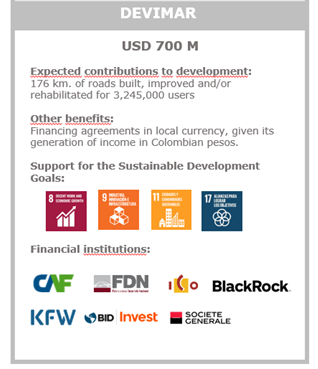Institutional financial resources
Strategic Alliances for development

CAF maximizes the impact and scope of its operations through strategic alliances, which allow mobilizing resources to achieve the Sustainable Development Goals (SDGs). These alliances allow CAF to diversify its financing sources and make combined financing (Blended Finance) to enhance development initiatives and offer more favorable financial conditions to its member countries.
The reimbursable and non-reimbursable funds that CAF offers from its Institutional Financial Resources Directorate range from lines of credit, co-financing, and thematic resources to technical assistance resources, as well as knowledge transfer.
Products
Global Partnerships
Partners by region
Mobilized resources
Cofinancing
Recent cofinancing agreements
Philanthropic Commitment
Alliances between private and multilateral foundations allow maximizing the development impact in sectors such as education, health, climate change, digitization, employment, among others.
Recent news with the philanthropic sector
Blended Finance
What is Blended Finance?
CAF´s Blended Finance Fact Sheet
What is the added value of Blended Finance?
- It makes feasible commercial financing towards projects that would not be commercially acceptable without the risk mitigation provided by the structure.
- It creates new investment opportunities, by unlocking commercial financing directed towards the Sustainable Development Goals.
- It is a strategic tool to close the gap in the financing needs of development projects.
Principles proposed by the OECD
The growing relevance of Blended Finance has resulted in the need to define principles as guides for its achievement. The OECD has proposed the following objectives as guidance:


Blended Finance in CAF at a glance
The role of Blended Finance in COVID-19
Building forward better
Blended Finance can catalyze investments that contribute to accelerate economic recovery after COVID-19 and progress in achieving Sustainable Development Goals. According to the OECD, Blended Finance should target specific country's priorities in those sectors where the reconstruction can have a maximized impact.
Some sectors to be prioritized by Blended Finance actors include but are not limited to SME’s, women and girls support, protection and creation of sustainable jobs, health support, and investment aligned with countries’ specific priority SDGs.
Benefited Projects
Banco Guayaquil


In 2019, CAF structured a Blended Finance for Banco Guayaquil totaling USD 75 M, aimed to support SME’s and Smart Agriculture in Ecuador, together with Proparco, BIO, Eco-Business Fund, Multibank (Panama), and Banco de Occidente (Panama). The facility will benefit between 1,000 and 1,500 SME’s and investments in green businesses, energy efficiency, and smart agriculture.
This innovative structure combined co-financing with development agencies and an AB loan in one single scheme, attracting European agencies and private banks. It also provided technical assistance resources to strengthen environmental and social management. Thus, materializing CAF's catalytic role, by creating the necessary conditions for the participation of private capital and supporting SDG #2 (Zero Hunger), #7 (Affordable and non-polluting energy), #8 (Decent work and growth economic), and #17 (Partnerships to achieve the Goals).
Concesionaria Desarrollo Vía al Mar (DEVIMAR)


This Blended Finance structure for Concesionaria Desarrollo Vial al Mar reached USD 700 M, attracting resources from the private and development sectors, both in USD and in COP from CAF, Financiera de Desarrollo Nacional (FDN), Instituto de Credito Oficial (ICO), KFW, IDB Invest, Société Générale, and BlackRock Debt Fund.
The added value of this Blending Finance was the combination, under competitive financial conditions, of a significant volume of resources from the private sector towards a strategic project for Colombia's development. It can be highlighted the relevance of local currency financing, in Colombian pesos, mitigating currency risk.
Proyecto Ferroviario Ferrocarril Central


In order to make viable long-term finance for infrastructure projects, CAF, through its subsidiary CAF-AM, created the CAF-AM Ferrocarril Central Financial Trust for USD 350 M, equivalent to 3,000 M of Indexed Units.
The Ferrocarril Central Railway project is a key piece for the logistics development of Uruguay. It will be developed under the Public-Private Partnership (PPP) modality and involves the financing, design, construction, rehabilitation and maintenance of 273 km of railway infrastructure between the port of Montevideo and the city of Paso de los Toros.
The total financing included a long-term loan granted by CAF of USD 85 M, which, together with the resources of the Debt Fund of USD 350 M and other investors, reaching USD 855 M.
Global platforms and knowledge transfer
Our participation in Platforms and working groups contribute to CAF's position as the leading development bank in the region and a global benchmark. These lectures constitute a strategic source of knowledge, best practices, new global partners and financial resources. Thus, CAF can promote increasingly innovative projects with greater impact.
Currently, CAF is part of 2 plataforms:

IDFC, created in 2011, is the leading group of 26 national and regional development banks around the world, the majority active in emerging markets.
USD 1,5 BN |
USD 288 BN |
26 |
| in green financing since 2015 | in green financing during 2022 | active members |

The Finance in Common Summit brings together more than 500 national and regional public development banks to discuss their role, ambition, challenges and opportunities.
530+ |
USD 2,3 BN |
10% to 12% |
| public development banks national and regional |
in actives | of total global investment |













